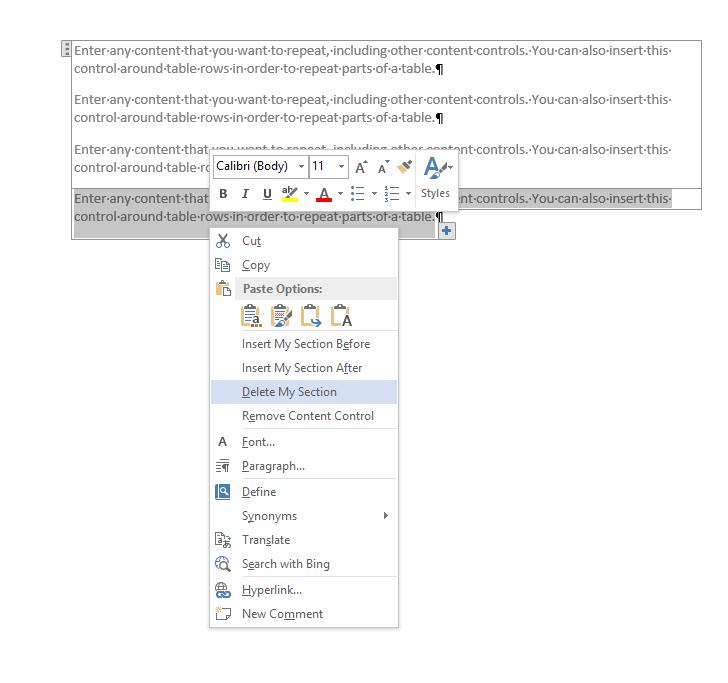

- MICROSOFT WORD CONTENT CONTROL EDITS HOW TO
- MICROSOFT WORD CONTENT CONTROL EDITS CODE
- MICROSOFT WORD CONTENT CONTROL EDITS PASSWORD
- MICROSOFT WORD CONTENT CONTROL EDITS FREE
(2) Check the option of Content control cannot be deleted (1) Enter a name for this content control in the Title box Step 3: In the coming Content Control Properties dialog box, Step 2: Go ahead to click the Properties button on the Developer tab.
MICROSOFT WORD CONTENT CONTROL EDITS HOW TO
Note: Click to know how to add the Developer tab into the Ribbon: Show developer tab/ribbon in Word Step 1: Select the part of document you will protect, and then click the Rich Text Content Control button on the Developer tab. This method will guide you to lock a specified part of a document with adding a content control in Microsoft Word easily.
MICROSOFT WORD CONTENT CONTROL EDITS PASSWORD
Up to now, the specified sections have been protected by your specified password already. (2) Enter your password in the both Enter new password (optional) box and Reenter password to confirm box Step 5: In the throwing Start Enforcing Protection dialog box, Step 4: Go ahead to click the Yes, Start Enforcing Protection button in the Restrict Editing pane. (4) In the popping up Section Protection dialog box, only check the sections you will protect, and then click the OK button.


(2) Click the following box, and then specify the Filling in forms from the drop down list

(1) Check the option of Allow only this type of editing in the document Step 3: In the Restrict Editing pane, go to the Editing restrictions section, and: Note: In Word 2007, you need to click the Protect Document > Restrict Formatting and Editing on the Review tab. Step 2: Show the Restrict Editing pane with clicking the Restrict Editing button on the Review tab. Then add a continuous break at the end of the part of document with same way. Step 1: Put the cursor before the part of document you will protect, and then click the Breaks > Continuous on the Page Layout tab. The first method will guide you to add section breaks in current document, and then lock specified sections easily. Lock specified sections of document in Word
MICROSOFT WORD CONTENT CONTROL EDITS FREE
Free Downloadīring Tabbed Editing And Browsing To Office (Include Word), Far More Powerful Than The Browser's Tabs. All Rights Reserved.More Than 100 Powerful Advanced Features for Word, Save 50% Of Your Time. Incidentally, the reasons for using the convoluted syntax: ActiveDocument.Bookmarks("Text2").Range.Fields(1).Result.Select
MICROSOFT WORD CONTENT CONTROL EDITS CODE
The UserForm code could fill in the document form (with or without using form fields in the document) and validation of UserForm controls is very easy to set up. For this and other reasons, a UserForm (Microsoft-speak for a custom dialog box) is usually a much more elegant solution for form filling than a document-based form. MsgBox "The first three letters must be 'KLM '"Įven this looks a little clunky on screen, because you can see the the cursor go to the next formfield before jumping back to the previous one (and Application.ScreenUpdating = False doesn't help you can fix this using the LockWindowUpdate API, but that is beyond the scope of this article). The following pair of macros working together do workĪpplication.OnTime When:=Now + TimeValue("00:00:01"), Name:="GoBacktoText2" MsgBox "The first three letters must be 'KLM ', in uppercase", vbInformationĪctiveDocument.Bookmarks("Text2").Range.Fields(1).Result.Selectįortunately, you can get round this timing bug (as indeed you can get around most of Word VBA's timing bugs) by using Application.Ontime. If Len(.Result) > 0 And Left$(.Result, 3) "KLM" Then Unfortunately, the following macro doesn't work - the macro runs too quickly, and as a result, although the cursor does return to the original formfield for an instant, it then jumps to the formfield you tabbed to or clicked in: However, if you want to perform some validation that is not catered for by the above dialog, you will have to use a macro, assigned as the Exit macro for the appropriate formfield using the above dialog. (I'm not sure what "Current Date" and "Current time" are doing there - you could use ordinary fields to produce those but the rest are useful). If the user then enters an invalid entry in the formfield they will be intercepted when they try to leave it: How to validate the contents of a formfield in a Word formīy right-clicking on a text form field and selecting Properties, you can set the Type and Format boxes to provide validation.


 0 kommentar(er)
0 kommentar(er)
